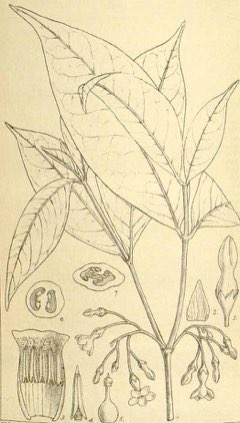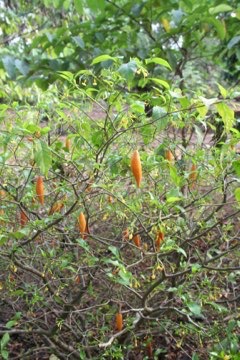 |
|
http://www.edibleplants.org |
 |
| Marco Schmidt[1] wikimedia.org |
Translate this page:
Summary
Tabernanthe iboga or Iboga is a perennial small shrub about 4 m in height and native to western Central Africa. The leaves are small and green. The flowers are white and pink. The fruits can be oval or round and orange in color. No plant part is edible but the plant is of medicinal importance. In particular, the root is hallucinogenic, aphrodisiac, febrifuge, and tonic. It is taken in different forms as relief from tiredness, hunger, and thirst, or as treatment for coughs, urinary infections, and conjunctivitis. The leaves, on the other hand, are anesthetic and aphrodisiac, and used against toothache. The latex is anthelmintic. However, there are serious side effects using this plant thus caution should be observed.
Physical Characteristics

 Tabernanthe iboga is an evergreen Shrub growing to 1.5 m (5ft) by 1.5 m (5ft) at a fast rate.
Tabernanthe iboga is an evergreen Shrub growing to 1.5 m (5ft) by 1.5 m (5ft) at a fast rate.
See above for USDA hardiness. It is hardy to UK zone 10.
Suitable for: light (sandy), medium (loamy) and heavy (clay) soils. Suitable pH: mildly acid, neutral and basic (mildly alkaline) soils. It can grow in semi-shade (light woodland) or no shade. It prefers moist or wet soil.
UK Hardiness Map
US Hardiness Map
Synonyms
Iboga vateriana Braun-Blanq. & K.Schum Tabernanthe albiflora Stapf Tabernanthe bocca Stapf Tabernant
Plant Habitats
Edible Uses
References More on Edible Uses
Medicinal Uses
Plants For A Future can not take any responsibility for any adverse effects from the use of plants. Always seek advice from a professional before using a plant medicinally.
Anaesthetic Analgesic Anthelmintic Aphrodisiac Febrifuge Hallucinogenic Odontalgic Ophthalmic
Sedative Tonic Urinary
Iboga root is very important in the initiation ceremonies of certain African tribes. The root bark can be eaten whole; or it can be crushed and ground then rolled into small balls; sometimes it is mixed with other ingredients; sometimes it is taken as a decoction of the crushed roots. The root is mainly employed as a hallucinogenic, a catalyst for spiritual discovery, and to seek information from ancestors and the spirit world, hence 'coming to terms with death'. Iboga is usually taken in large quantities in these ceremonies[299 ]. Iboga is also taken, usually in rather smaller quantities, as a means of divination to diagnose situations and also for therapeutic purposes[299 ]. The roots are considered to be aphrodisiac, febrifuge and tonic[299 ]. A decoction is often taken as a means of combating tiredness, hunger and thirst in situations such as hunting when it can be necessary to overcome physical stress[299 ]. A root macerate in palm wine is taken to soothe coughs, whilst the root decoction is drunk to treat urinary infections[299 ]. The pounded roots are also used in the curing ceremony (called 'zebola') for treating psychosomatic afflictions[299 ]. A decoction of the root is used for eye drops to treat conjunctivitis[299 ]. The leaves are considered to be anaesthetic and aphrodisiac[299 ]. The warmed leaves are rubbed on the gums to calm toothache[299 ]. The latex obtained from the plant is taken as an anthelmintic[299 ]. The active compounds, present in the root, root bark, stem bark, leaves and seeds of the plant, are indole alkaloids. About 20 have been identified so far[299 ]. The highest concentrations of alkaloids occur in the root bark (5 - 6%), followed by the roots (1 - 2.5%), stem bark (2%), seed (1%) and leaves (0.4 - 0.8%)[299 ]. Ibogaine (ibogan class) is the most important alkaloid present in all plant parts except the seeds. The main activities of ibogaine are on the central nervous system and on the cardiovascular system. At low doses, it exerts primarily a stimulant effect, increasing alertness and reducing fatigue, hunger and thirst. At higher doses, the primary effects are hallucinations, with unpleasant possible side effects such as anxiety and depression with fear or rage[299 ]. The peak effect is reached 1 - 3 hours after swallowing the drug; it subsides gradually, ending in complete insomnia and lethargy. These effects can last for 2 - 5 days. Apart from the psychological effects, the physical effects include tremor, light sensitivity, nausea and vomiting, loss of muscular coordination and prolonged and often painful muscle spasms, all in a dose-dependent way[299 ]. Toxic doses may produce convulsions, paralysis and death from respiratory arrest[299 ]. Most activities have been tested with purified ibogaine, but during initiation ceremonies powdered root bark is usually taken, which is more powerful as it contains a range of related alkaloids[299 ]. Ibogaine is a potent cholinesterase inhibitor, and the root extract is even 100 times stronger in its inhibitory effect because of the additional effects of the alkaloids tabernanthine, ibogamine and the more distantly related iboluteine. This property contributes to the anti-fatigue properties of ibogaine, and results from an increased sensitivity to adrenaline, bringing about a transient excited state of the sympathic nervous system[299 ]. Despite the reputation of iboga as an aphrodisiac, ibogaine did not produce a stimulation of sexual functions in various trials[299 ]. Tests have not shown ibogaine to have a significant analgesic effect[299 ]. Recent research indicates that ibogaine has a novel pharmacological mechanism of action, acting strongly on a variety of different receptors in the brain, resulting from complex interactions between neurotransmitter systems. There is no consensus yet on how ibogaine works precisely, but it is known to inhibit the re-uptake of the neurotransmitter serotonin, which can cause hallucinations[299 ]. However, the suggestion by laymen that ibogaine has considerable potential in the field of psychotherapy is premature. Research has shown that ibogaine is converted in the liver to noribogaine, which fills opiate receptors, thus eliminating withdrawal symptoms. Ibogaine also stimulates nicotinic receptors in the cerebellum, which contributes to modulating the dopamine reward circuit. At high doses though, ibogaine is toxic as it destroys neurons in the cerebellum[299 ]. There is evidence to suggest that ibogaine has considerable potential in treating addictions to heroin, cocaine, alcohol, nicotine, caffeine, amphetamine, desoxyephedrine or methadone, or combinations of these. Several methods to arrest the physiological and psychological aspects of dependency on drugs by using ibogaine have been patented in the United States. Treatments are claimed to be effective for 70 - 100% of the cases. However, the serious side effects of ibogaine make its use potentially harmful and additional clinical studies are needed to determine if and how it can be used safely[299 ].
References More on Medicinal Uses
The Bookshop: Edible Plant Books
Our Latest books on Perennial Plants For Food Forests and Permaculture Gardens in paperback or digital formats.

Edible Tropical Plants
Food Forest Plants for Hotter Conditions: 250+ Plants For Tropical Food Forests & Permaculture Gardens.
More

Edible Temperate Plants
Plants for Your Food Forest: 500 Plants for Temperate Food Forests & Permaculture Gardens.
More

More Books
PFAF have eight books available in paperback and digital formats. Browse the shop for more information.
Shop Now
Other Uses
Other Uses: None known
Special Uses
References More on Other Uses
Cultivation details
Newly planted young shrubs can reach a height of about 60cm after 3 years[299 ]. If produced from cuttings, they can commence flowering in just 4 months[299 ]. Plants often flower and produce fruit all year round[299 ]. Plants can be cut back into the old wood, resprouting well from the trunk[299 ].
References Carbon Farming Information and Carbon Sequestration Information
Temperature Converter
Type a value in the Celsius field to convert the value to Fahrenheit:
Fahrenheit:
The PFAF Bookshop
Plants For A Future have a number of books available in paperback and digital form. Book titles include Edible Plants, Edible Perennials, Edible Trees,Edible Shrubs, Woodland Gardening, and Temperate Food Forest Plants. Our new book is Food Forest Plants For Hotter Conditions (Tropical and Sub-Tropical).
Shop Now
Plant Propagation
Seed - best sown as soon as it is ripe because after a few months the seed coat dries out, making it difficult for the seedling to emerge[299 ]. Sow the seed in a semi-shaded position in a nursery seedbed or in individual containers[299 ]. Germination is slow and irregular, ranging from a few weeks to a few months. Scarification prior to sowing increases the germination rate considerably[299 ]. Young plants can be transplanted to their final location after 2 - 3 months, when the root has become twice as long as the stem[299 ]. Cuttings of about 25 cm long and 1 cm in stem diameter root easily in humid soil.[299 ].
Other Names
If available other names are mentioned here
bitter grass, bitter-grass, bois amer, bois sacré, dibughi, dihoa, eboka, eraga, iboga, ibogo, leaf of god, leaf-of-god, lihoka, ochima, sacred wood, sacredwood, éboga.
Native Range
TROPICAL ASIA: Cambodia AFRICA: Tanzania, Central African Republic, Democratic Republic of the Congo, Congo, Gabon, Equatorial Guinea, Angola
Weed Potential
Right plant wrong place. We are currently updating this section.
Please note that a plant may be invasive in one area but may not in your area so it's worth checking.
Conservation Status
IUCN Red List of Threatened Plants Status : This taxon has not yet been assessed

Growth: S = slow M = medium F = fast. Soil: L = light (sandy) M = medium H = heavy (clay). pH: A = acid N = neutral B = basic (alkaline). Shade: F = full shade S = semi-shade N = no shade. Moisture: D = dry M = Moist We = wet Wa = water.
Now available:
Food Forest Plants for Mediterranean Conditions
350+ Perennial Plants For Mediterranean and Drier Food Forests and Permaculture Gardens.
[Paperback and eBook]
This is the third in Plants For A Future's series of plant guides for food forests tailored to
specific climate zones. Following volumes on temperate and tropical ecosystems, this book focuses
on species suited to Mediterranean conditions—regions with hot, dry summers and cool, wet winters,
often facing the added challenge of climate change.
Read More
Expert comment
Author
Baill.
Botanical References
Links / References
For a list of references used on this page please go here
A special thanks to Ken Fern for some of the information used on this page.
Readers comment
| Add a comment |
|
If you have important information about this plant that may help other users please add a comment or link below. Only comments or links that are felt to be directly relevant to a plant will be included. If you think a comment/link or information contained on this page is inaccurate or misleading we would welcome your feedback at [email protected]. If you have questions about a plant please use the Forum on this website as we do not have the resources to answer questions ourselves.
* Please note: the comments by website users are not necessarily those held by PFAF and may give misleading or inaccurate information.
To leave a comment please Register or login here All comments need to be approved so will not appear immediately.
|
Subject : Tabernanthe iboga
|
|
|
|